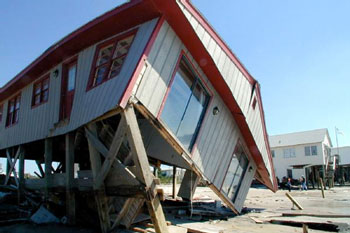NAGS HEAD — Supporters of the N.C. Senate’s now-infamous sea-level rise bill warned that property insurance rates will go through the roof if the state were allowed to plan for the three-foot rise in ocean levels that most scientists expect by the end of this century.
The insurance industry in the state is caught in the middle of an issue that could have enormous impact on their future bottom line — depending on what happens to the fiscally-troubled National Flood Insurance Program. Those in the insurance industry, however, doubt that legislative action on sea-level rise will have any effect on property rates.
Supporter Spotlight
“The state of North Carolina doesn’t tell the National Flood Insurance Program how to set the rates,” said Fletcher Willey, owner of a Nags Head insurance agency. “A bill in the North Carolina General Assembly does not mean anything to the National Flood Insurance Program.”
But there’s no guarantee that private insurers won’t have to provide flood coverage in the future.
Those in the business of insuring property are at a loss, so to speak, on how to respond to a potentially dire but slow-moving threat that is buffeted by powerful, and conflicting, political winds. Not only could the risk, whatever it is, be far in the future, it is currently more the federal government’s headache than that of any private insurer.
“The perils we insure against are wind, lightning and hail,” said Ray Evans, general manager of the N.C. Rate Bureau. “As a result, the rising sea levels really do not come into our calculus.”
Although the National Flood Insurance Program by default insures nearly all property in flood zones nationwide against flooding, one of the proposed reforms of the program is privatization.
Supporter Spotlight
The Beach Plan, a state-run pool of private insurance companies in the state, provides wind and hail coverage for most property along the coast.
 Gina Schwitzgebel |
Gina Schwitzgebel, general manager of the N.C. Joint Underwriting Association and the North Carolina Insurance Underwriting Association — the official name of the Beach Plan — said in an e-mail that, by law, rates are set by the Rate Bureau, with an added surcharge of 5 percent for wind and hail coverage and a 15 percent surcharge for homeowners’ insurance.
Evans said that the statute provides the framework under which the bureau operates, and lawmakers can change the law however and whenever they see fit. “It’s how we exist,” he said. “They have a great deal of authority.”
The insurance commissioner has some discretion in implementation of the law, Evans said, but he must abide by the statute.
State Insurance Commissioner Wayne Goodwin, through a spokesperson, declined to comment.
In general, climate change and its potential impact have gotten the attention of the insurance industry, which is immediately concerned about property damage from disasters created by increased storm surge and wind destruction from powerful hurricanes and tornados. Sea level rise as a specific issue is not yet an action item.
“From our perspective, it’s hard for insurance companies to figure out how rising sea levels might affect risk of loss in coastal areas because it’s proceeding at such a slow rate,” said Robert Detlefsen, vice president of public policy for the National Association of Mutual Insurance Companies, a national trade association that represents 1,400 members. “And insurers, when they write homeowners policies, they are writing policies that are in effect for 12 months.”
Insurance companies establish rates by studying historic data, he said. In the last 10 years or so, actuaries have also been using catastrophe models developed by specialized firms that incorporate climate and other data to calculate projections.
Even with the best data, he said, the industry is still subject to political will, especially if a rate hike is requested.
Often, the rate increase is denied, and the insurance providers — as happened in North Carolina — decide to no longer provide the coverage.
“No company wants to go insolvent,” Detlefsen said, adding that sometimes states force companies to provide coverage. “That question helps to explain why insurers are very much interested in the health of the National Flood Insurance Program.”
Flooding is notoriously difficult to predict and extremely expensive to insure against, which is why Congress by necessity in 1968 created the federal flood insurance program. The intent was to reduce flood damages with better management while providing an affordable flood insurance program for property owners.
Mortgage companies now require federal flood insurance policies in flood-prone areas. Critics of the program say that numerous property owners file claims year after year for repeated damage, and that the artificially low premium rates in effect subsidize irresponsible development in areas subject to flooding.
By statute, the program is barred from projecting any future consequences, so floodplain maps and models do not account for potential sea level rise, or projected erosion rates.
Starting in 2001, North Carolina became the first state to write the state floodplain maps for the Federal Emergency Management Agency, working as a cooperating technical partner, said Randy Mundt, outreach coordinator for the N.C. Floodplain Mapping program at the state Department of Public Safety.
 |
Since then, he said, floodplain maps, which are available digitally online, have been updated in all 100 counties. The goal is to update them every five years, and so far eight counties have preliminary new updates. The 30-year-old coastal flood hazard model used in mapmaking is also in the process of being updated.
As a result, he said, the state has some of the most accurate floodplain maps in the nation.
“We’ve had great leadership and support for this,” Mundt said, “which has saved taxpayers an enormous amount of money.”
Mundt said determination of base flood elevation is calculated by the current conditions, and the frequent map updates reflect changes in conditions. Although FEMA maps are snapshots of “today,” communities have the option to adopt a flood damage prevention ordinance that would require consideration of projected future conditions in development standards.
Wake County, Greensboro, Wilmington and Cary, which are affected by riverine flooding, have such plans in place, but Dare County, which statewide has the highest coverage amount of flood insurance, does not.
According to statistics on the FEMA website, as of April 30, 2012, unincorporated Dare County had 10,192 federal flood insurance policies in force, covering $2,434,993,100 worth of property, with $6,280,109 in premiums paid for the policies. The second-highest property coverage statewide was in unincorporated New Hanover County, with $1,519,013,900.
In the 2012 Dare County Land Use Plan, it states that the county planning board decided to “reserve judgment” on initiatives addressing the potential threat of rising seas “due to the lack of consensus on the issue” and the ongoing debate about the impacts of climate change and global warming.
A 2001 FEMA report on how the national flood insurance would be impacted by a rise in sea level, based on United Nations projections of a 1-foot to 3-foot increase by 2100, concluded that the rating system could readily respond to a 1-foot rise, and would have until 2050 before seeing impacts of a 3-foot rise.
The report recommended that FEMA should continue to monitor scientific projections on future changes in sea level and encourage measures that mitigate the impacts of sea level rise.
“The 60-year timeframe over which this gradual change occurs provides ample opportunity for the NFIP to consider alternative approaches to the loss control and insurance mechanisms of the NFIP and to implement those changes that are both effective and based on sound scientific evidence,” the report said
The report, assuming continued development trends, estimated the increase in the expected annual flood damage by 2100 for a representative insured property subject to sea level rise at 36 percent to 58 percent for a 1-foot rise and 102 percent to 200 percent for a 3-foot rise.
Contacted this week, a FEMA spokesperson, speaking only on background in an e-mail, said that data on sea-level rise, although not reflected on flood insurance rate maps, does incorporate the most current available flood hazard and risk data and applies the latest available science.







